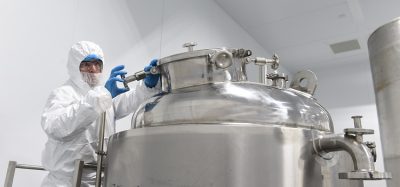The fundamentals of contemporary supply chain management
Posted: 16 February 2021 | Nikki Withers (European Pharmaceutical Review) | No comments yet
Effective supply chain management can cut costs, improve service and enhance company revenues; however, the pharma industry has historically been a slow adopter of leading-edge practices. Nikki Withers discussed the fundamentals of contemporary supply chain management with Ed Sweeney, Professor of Logistics and Systems at Aston University, who believes that the gap has started to close between pharma and the recognised global leaders in the sector.


WITH THE ROLLOUT of approved COVID-19 vaccines now underway in many countries, it is imperative that an efficient supply chain is in place to deliver the full potential of the R&D efforts of 2020. “The scale of this challenge may not have crossed some people’s minds,” said Ed Sweeney, Professor of Logistics and Systems and Head of the Department of Engineering Systems & Supply Chain Management (ESSCM) at Aston University in the UK. “The vaccine is not going to be worth anything to us unless, in a UK context, we can distribute it to tens of millions of people and more importantly, in a global context, we can get it safely and quickly to billions.”
Now that all eyes are on the distribution of these vaccines, it is important to note that, historically, the pharmaceutical industry has been a slow adopter of leading-edge supply chain practices. “Every industry has its unique characteristics, but those working in pharma would always say that the effective adoption of contemporary supply chain management is difficult due to the regulatory environment that they work in,” explained Sweeney. He added that the strong product focus of R&D also has an impact. “In other sectors, R&D is increasingly aimed at improving processes, as well as developing new products. I suspect both these factors have contributed to the industry arriving late to the game in terms of supply chain process innovation.”
Contemporary supply chain management
Supply chain management describes the management of all activities in any of the companies involved in a supply chain to provide the highest possible level of customer service at optimum total supply chain cost and investment.1 Sweeney summarises supply chain management by means of four absolutes or fundamentals: the objectives, philosophy, flow and customer/supplier relationships.
Objectives
Firstly, there needs to be absolute clarity about what the objectives of the supply chain are. These should enable high levels of customer service in targeted markets/segments while also optimising total supply chain investment and cost. “This is about the whole concept of value and how the supply chain as a collective entity, or as a network of companies, creates that value,” said Sweeney. “This should be not only from the shareholder point of view, but also from the customer.”
Philosophy
We need to have high levels of integration between companies upstream and downstream in supply chains”
Knowing the philosophy of the supply chain is the next step, which Sweeney noted is driven by integration. “We need to have high levels of integration between companies upstream and downstream in supply chains,” he said. “My experience in the pharmaceutical industry is that this need is more pressing than ever because we know that waste and non value‑adding activities happen as a direct result of fragmentation. We need to replace fragmented approaches with those that are characterised more by integration.” He added that supply chain management means thinking beyond the established boundaries, strengthening the linkages between the functions and finding ways for them to pull together. This leads us to the third fundamental, flow management, and the means by which this is achieved.
Flow management
The key to assuring high levels of integration requires effective management of the various flows of the chain, ensuring they are efficient and effective. “Arguably, the key flow is the flow of information – it is impossible to imagine any 21st century supply chain being able to operate without a sophisticated and complex IT backbone,” said Sweeney. “We know from experience, not just in pharma but in other sectors, that if you want to manage material and money flows in supply chains efficiently and effectively, you must have control of information and this requires the adoption of new technologies.” Furthermore, the entire chain must be managed in an integrated and holistic manner, driven by the overall service and cost objectives, as described earlier.
Relationships
Finally, this holistic approach requires a reappraisal of the way in which both internal and external customer/supplier relationships are created and managed. “If you are serious about replacing fragmentation with integration, you must have a strong focus on relationships. This can be between different companies in that ecosystem or relationships between different functions and professions within the same business. Ultimately, we must remember that relationships are about people.” Sweeney noted that one of the biggest manifestations of the application of supply chain philosophy in recent years has involved the move away from adversarial relationships throughout the supply chain towards relationships that are based on mutual trust and benefits, openness and shared goals and objectives.


The importance of innovation
Historically, the automotive sector, and particularly the Japanese automotive sector, has embraced innovation and led the way in supply chain management. However, the gaps between the world‑class leaders and others appear to be narrowing. “In the last decade, the level of supply chain professionalism that we have seen in the pharma sector has increased beyond recognition. Pharma is in no way a laggard; it just was not an early adopter,” observed Sweeney. He added that the nature of competition in the pharmaceutical industry is different to other sectors; not least because it takes years to develop a new product and huge amounts of retained profits are reinvested in new product development. “Pharma companies face different competitive pressures to those in the consumer electronics or the automotive industry. However, I think the competitive landscape has changed significantly in recent years and in some ways that has provided some of the impetus for the rapid uptake of some of these contemporary supply chain practices. That in turn has helped to reduce the gap between the recognised global leaders and some of the leading companies in the pharma sector.”
Added complications
In the last decade, the level of supply chain professionalism that we have seen in the pharma sector has increased beyond recognition”
The current efforts to distribute the approved COVID-19 vaccines highlights a further challenge that the pharmaceutical industry faces – temperature‑controlled logistics. “The temperature control aspect of these vaccines is a massive issue and one of the elements of complexity that supply chain designers will have needed to be acutely conscious of,” Sweeney affirmed. “We need an incredible supply chain, not only to distribute the vaccine to patients, but the pre-manufacturing, manufacturing and everything in between. I do not think this was at the front and centre of our debate to the extent it should have been, and I think it is one of the biggest challenges we are facing now.”
He added that when lockdown was first announced, the amount of collaboration that happened between companies in both the food and pharma industry who were usually arch competitors was astonishing. “From a UK context, the mantra of ‘let us keep Britain fed’, completely overtook short-term commercial imperatives. Now, as it turned out, the food sector has done very well in the past few months, as has the third‑party logistics sector that supports it; it is one of the fastest growing sectors in the economy right now.”
Finally, Sweeney stressed the importance of attracting new talent to the industry. “One of the biggest single challenges we face is around talent,” he said. “To find new and better ways of doing things, whether this is looking at the processes within the manufacturing and distribution of the supply chain or introducing new technologies, we need to attract talent into our profession and support up‑skilling and retention.”
He concluded: “The challenges that the supply chain industry is trying to grapple with are many and various. It just requires supply chains to be re‑imagined in a very logical and systematic way and that technology is being used appropriately in the mix.”
![Ed Sweeney [Credit: Edward Moss/ Aston University staff].](https://www.europeanpharmaceuticalreview.com/wp-content/uploads/Ed-Sweeney-headshot-120x120.jpg)
![Ed Sweeney [Credit: Edward Moss/ Aston University staff].](https://www.europeanpharmaceuticalreview.com/wp-content/uploads/Ed-Sweeney-headshot-120x120.jpg)
[Credit: Edward Moss].
Ed Sweeney is Professor of Logistics and Systems, and Head of the Department of Engineering Systems & Supply Chain Management (ESSCM) at Aston University. In this capacity he leads a multidisciplinary group of academics with interests in logistics, transport, supply chain systems and allied fields. Ed’s current research focuses on issues of supply chain design and integration, with a particular emphasis on the divergence between theory and practice. Ed was previously Director at the National Institute for Transport and Logistics (NITL), based at the Technological University of Dublin (TUD) in Ireland. Here, he was responsible for the Institute’s award-winning supply chain management (SCM) development programmes. Ed has worked and lectured in over 70 countries in Europe, North America and Asia and is an experienced researcher, with over 200 publications including books, papers in international peer-reviewed academic journals and leading trade publications.
Reference
- Sweeney E, Grant DB, Mangan, JD. The Implementation of Supply Chain Management Theory in Practice: an empirical investigation. Supply Chain Management: an International Journal. 2015;20(1).
Issue
Related topics
Cold Chain Supply, Distribution & Logistics, Drug Supply Chain, Industry Insight, Informatics, Supply Chain, Vaccines, Viruses








